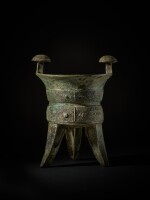Vestiges of Ancient China
Vestiges of Ancient China

An archaic bronze ritual wine vessel (Jia), Late Shang dynasty | 商末 青銅饕餮紋斝
Auction Closed
September 19, 02:55 PM GMT
Estimate
70,000 - 90,000 USD
Lot Details
Description
An archaic bronze ritual wine vessel (Jia)
Late Shang dynasty
商末 青銅饕餮紋斝
the inside of the handle carved with an inscription comprising a ju and three tian characters
刻銘:
舉 田田田
Height 8¼ in., 21 cm
Galerie Christian Deydier, Paris.
Important European Private Collection.
戴克成,巴黎
重要歐洲私人收藏
Ancient Chinese Ritual Bronze Vessels, Galerie Christian Deydier, Paris, 2013, cat. no. 2.
《Ancient Chinese Ritual Bronze Vessels》,戴克成,巴黎,2013年,編號2
Jia, an important type of bronze ritual vessel, first appeared during the Erlitou culture (c.1900-c.1500 BC). This vessel form became popular between the Shang and early Western Zhou dynasty, before it was gradually replaced by other bronze types after the middle Western Zhou period. Chen Peifen notes that jia were used during the guanli 祼禮, a type of ancient ritual performed in the autumn and winter seasons (see Zhongguo qingtongqi cidian [The dictionary of Chinese archaic bronzes], vol. 1, Shanghai, 2013, p. 39). Zhu Fenghan concludes in his book that jia served as vessels to warm wine during ritual ceremonies, evidenced by the burnt marks and traces of water stains found on numerous excavated jia (Zhongguo qingtongqi zonglun / A Comprehensive Survey of Chinese Bronzes, vol. I, Shanghai, 2009, pp 168 and 169).
Compare a very similar bronze jia of the same form but with a slightly different taotie design, excavated at Qishan county, Shaanxi province, in 1972, now in the collection of Qishan County Musuem, attributed to the late Shang dynasty, illustrated in Zhongguo qingtongqi quanji [Complete series on Chinese bronzes], vol. 4, Shang 4, Beijing, 1996, pl. 58; and another sold in our London rooms, 15th March 1973, lot 406. A further related example is illustrated in Minao Hayashi, In Shū Jidai seidōki no kenkyū. In Shū seidōki souran [Research of bronze ware of Shang and Zhou dynasty], vol. 1, Tokyo, 1984, jia, no. 34; and another excavated at Xiaotun village in Anyang, Henan province, published in Zhu Fenghan, Zhongguo qingtongqi zonglun / A Comprehensive Survey of Chinese Bronzes, vol. 1, Shanghai, 2009, p. 172, fig. 3.33.9 (line drawing). A bronze jia of a slightly more elongated form, attributed to the early Anyang period, circa 14th / 13th century BC, from the collection of Yolanda and Paul Lippens, is published in Christian Deydier, The Lippens Collection of Ancient Chinese Bronzes, Hong Kong, 2019, cat. no. 12.
